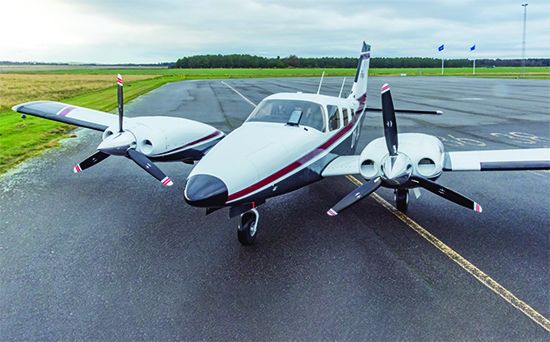For those stepping into the world of multi-engine airplanes, the Piper Seneca remains a popular twin for a few reasons. Flight schools tend to like Seneca I models because they are relatively inexpensive to maintain thanks to simple systems and reliable Lycoming IO-360 powerplants. Plus for students coming out of PA-28 models (especially the Arrow), the Seneca cockpit should be familiar.
For ownership, later-model Senecas are appealing because they move along at decent speeds (although they’re far from blistering fast) and have somewhat luxurious cabins. In a sales market where prices for piston twins haven’t really skyrocketed like piston singles, the venerable Seneca remains a strong seller. Here’s a refresh.
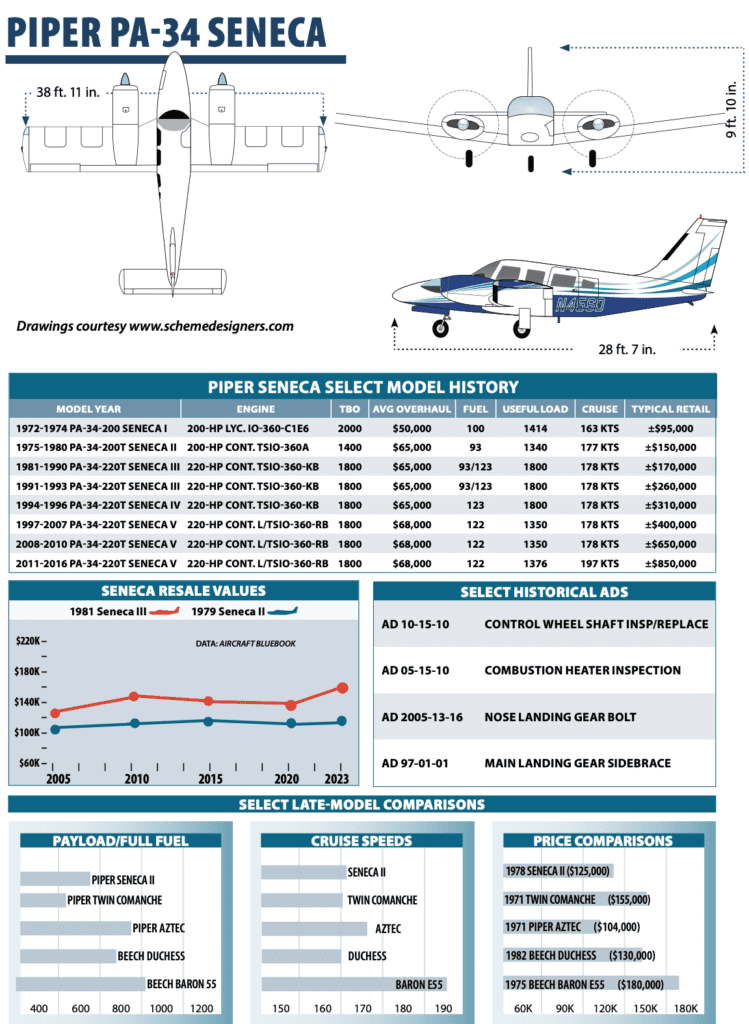
MODEL HISTORY
Deeply rooted in the Cherokee line, the Seneca first appeared in 1971. At the time, the Aztec—a good seller for Piper—and the Comanche were growing long in the tooth and Piper needed something fresh.
In some ways, the first Seneca I was a bit like Piper’s PA-28R Arrow (though the airframe was based on the successful PA-32 series—with a long and wide cabin and true seating for six) but with two counter-rotating Lycoming IO-360 engines. When it was first introduced, the Seneca I (at $63,000 typically equipped) was about the same price as the Twin Comanche C/R model, but with larger engines, a higher gross weight and a convenient rear cabin door. In three years, Piper sold 933 Seneca Is, dramatically outdoing the Aztec and Comanche.
The original Seneca I was a good start, but it was lacking, too. Pitch stability wasn’t the best and the controls were on the heavy side. The airplane also had noticeable Dutch roll in turbulence, which would tax the stomachs of the back-seat passengers. If you’ve flown one, you know that its single-engine performance at higher gross weight (the gross weight was increased from 4000 to 4200 pounds for more fuel or more payload) was marginal, at best. With the increase, single-engine rate of climb sank from 230 FPM to 190 FPM and single-engine ceiling from 5200 feet to 3650 feet.
Piper continued to improve the Seneca with the PA-34-200T Seneca II. More changes were made to the control system to improve handling. The aileron/rudder interconnect was removed and with it went some control heaviness. But the big change for the Seneca II was its engines—ditching the four-cylinder Lycomings in favor of six-cylinder turbocharged Continental TSIO-360-E engines with fixed wastegates.
Rated at the same 200 HP at sea level, they produced 215 HP at 12,000 feet. Flying high and fast is nice, of course, but twin drivers worry more about high-altitude engine-out performance. Here, the Seneca II was a different beast entirely. The airplane got a higher gross weight, too, increasing by 370 pounds to 4570 pounds. However, the zero-fuel weight stayed at 4000 pounds, so the benefit was a mixed blessing. The Seneca II also got optional extended-range fuel tanks that increased usable fuel from 93 to 123 gallons. The campaign against noise and vibration continued with the addition of a three-blade prop option, which weighed 46 more pounds.
The popular club seating option was also introduced, as was a Janitrol heater and optional fan to move heated or ambient air through the cabin. In later years, some system changes and options were added, such as a priming system to make engine start easier, more powerful brakes, modifications to the instrument panel, plus air conditioning. In 1980, a built-in oxygen system was offered.
The 1981 Seneca III was supposed to have the same T-tail and tapered wing as the Lance, but Piper found that the flying qualities weren’t as good as the company had hoped. The configuration was left unchanged. There were still significant changes to the Seneca III, however. A different variant of the Continentals was used, with 220 HP each. These engines had a higher RPM limit (2800 versus 2575 RPM). This, combined with fuel scheduling, resulted in maximum power of 220 HP, albeit time-limited to only five minutes.
Other changes to the Seneca III included a new and more modern instrument panel, a one-piece windshield and a switch to electric flaps.
The Seneca never went out of production, even during Piper’s troubled times in the late 1980s and early 1990s. As part of Piper’s transformation into New Piper, the Seneca was revamped yet again, being redubbed the Seneca IV and later, the Seneca V. Relatively few design changes were made, the most notable being new cowlings that result in higher speeds. Also, the interiors were markedly improved in recent models, while Garmin’s G1000 integrated avionics fill the instrument panel.
The last Seneca V models made in limited production somewhere around 2020 were over $1-million-plus airplanes. The current Aircraft Bluebook shows the typical retail price of a 2015 at $840,000.
PERFORMANCE
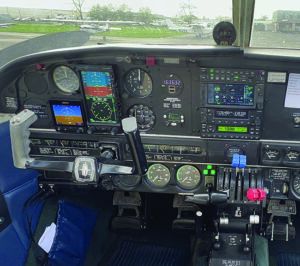
All of the Senecas offer fairly good short-field performance and sea-level fields of 3000 feet or so are no problem as long as both engines are turning. As noted in our accident review, the airplane can bite on landing, especially if approach speed isn’t kept under control.
For speed, the turbocharged models run in the 180-knot range in the high teens at 24 to 28 GPH. Down lower, or in the normally aspirated early models, figure on 165 knots at 65 percent. Limiting speeds are painfully low: 129 to 130 knots for gear extension; 138, 121 and 107 knots for 10-, 25- and 40-degrees flaps.
Loading the Seneca is about as easy as it gets. The fuselage is low to the ground, allowing rear passengers to climb on board easily, and the rear seats are easy to remove. The generous CG range permits flexibility in seat selection.
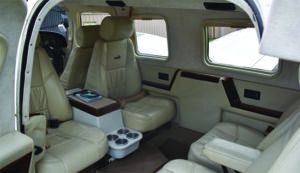
Early Senecas have useful loads in the 1200-pound range while the Seneca II averages closer to 1500 pounds. The latest iterations, the Seneca Vs, regressed due to added creature comforts causing higher empty weights—with useful loads in the 1300-pound range.
CABIN AND COMFORT
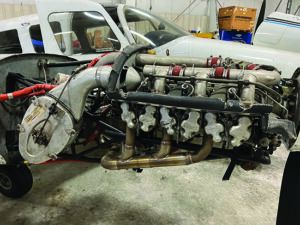
With its 4-foot-wide cabin, adequate seating for all but the biggest of six people and ample windows, the Seneca is long on comfort—and its club seating is especially popular. Given its payload, the Seneca is a good five-person airplane with some baggage or a four-person airplane with a lot of baggage.
From our experience, the flight deck visibility is subpar. The engine nacelles extend forward of the wing leading edge and combine with the long nose and wide-chord wing to block horizontal and downward visibility.
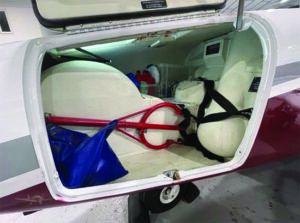
Heating and ventilation are typical Piper, with overhead and floor vents that provide enough air in most circumstances. Seats are reasonably comfortable but with a tendency to sag and wear with use. But new interior upgrades take care of that, while boosting the luxe in older models.
MODS, MARKET
Senecas, beginning with the II, came with fixed wastegate turbochargers. These are relatively simple and inexpensive to manufacture, but at the cost of efficiency as we’ll as longevity and a tendency to overboost due to sensitive throttle response. Owners say a must-have mod is to fit the engines with Merlyn automatic upper deck air controllers. We’ve heard good reports about these mods and other owners tell us intercoolers can also help. Visit www.merlynproducts.com.
Hartzell Propeller had an aggressive program to install three-blade propellers on the Seneca II and III. The STCs can replace either two-blade Hartzell or three-blade McCauley propellers. The three-blades offer better takeoff and initial climb and also eliminate the RPM/MP restriction applicable to the two-blade propellers. Contact Hartzell at www.hartzellprop.com.
The Piper Owner Society supports Seneca buying and ownership and is a good general resource for Pipers of all sorts. Contact www.piperowner.org. Another group is the Piper Flyer Association at www.piperflyer.com. There’s also the Piper Seneca Pilots & Owners Facebook group, with 285 members.
Choose your price point—from $90,000 to $800,000. As with any airplane, you’ll pay a premium for Senecas with the latest avionics, low-time engines and new paint. Search the market and you’ll find a wide variety to choose from—from well-worn Seneca Is that served hard duty on training lines to later-model Senecas that were well-kept family travelers. But no matter which one you pick, get an insurance quote first, and plan on completing thorough transition training—especially focusing on engine-out scenarios.
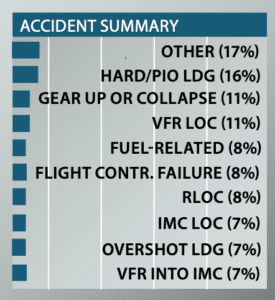
We have long thought of Piper’s comfortable, six-place Seneca as having truck-like handling while being overall forgiving of pilots seeking ratings or roomy personal transportation machines. After reviewing the 100 most recent Seneca mishap reports, we’re recalibrating our thinking.
The single most common type of accident involved pilots who couldn’t seem to land their airplane. Sixteen percent could not figure when to flare or how to avoid pilot-induced-oscillation (PIO) after touchdown. Two pilots hit so hard that they managed to curl all of the blades on one prop aft. Others made such huge fore-and-aft yoke inputs after initial runway contact that they beat the nosegear into submission/collapse.
Combined with eight runway loss of control (RLOC) events, we strongly recommend that any Seneca buyer not only inspect the airframe and gear for damage before buying, but get a solid checkout in how to achieve some degree of grace when returning one back to earth.
While we consider ourselves to be pretty jaded when it comes to ways to wreck airplanes, we were frankly amazed to find eight flight control failure events. We consider flight control failures to be extremely serious events and note that all were due to improper or unperformed maintenance.
Failure to do the most rudimentary inspection of the stabilator control cables in two Senecas caused the wires to fray and eventually fail in fatigue. After some wild gyrations, the pilots involved managed to get the airplanes on the ground without seriously injuring anyone.
Improper installation of the stabilator after maintenance resulted in four crashes. Electric pitch trim installed backward caused one crash as did chafing of the electric pitch trim wires—which led to intermittent trim runaways. In that case, the pilot knew about the problem and elected not to have it fixed as he thought he could handle it—until he couldn’t.
There were 11 VFR loss of control (LOC) accidents, quite a high number at first glance. However, all but one involved dual instruction and simulated or actual single engine approaches or go-arounds that went south.
For years we’ve looked at engine-out training accidents in which passengers were killed. Because of those tragedies, it is our opinion that, if a multi-engine training session is going to involve simulated single-engine work, taking a passenger is simply wrong.
Bad maintenance raised its head in five gear collapse events.
Pilot judgment played a big role in several accidents: Seven VFR into IMC, seven overshot landings and three pilots who descended below minimums and hit terrain.
There were but four engine/mechanical accidents—in two of them a prop threw a blade due to fatigue cracking. One involved a pilot who took off with the fuel servo in the left engine clogged with mud and debris—and did so after an A&P had inspected the servo and told the pilot that the airplane wasn’t airworthy. The engine quit at 50 feet and the airplane Vmc rolled into the ground.

